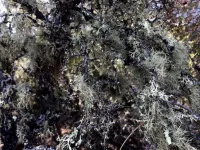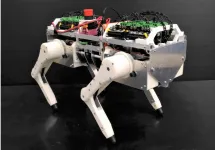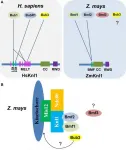(Press-News.org) Duluth, Minnesota - A new paper in the May issue of Nature Communications demonstrates why keeping local lakes and other waterbodies clean produces cost-effective benefits locally and globally.
A single season of a lake or water body with a harmful algal bloom that results in public do-not-drink orders, damages to fishing activity, lost recreational opportunities, decreased property values and increased likelihood of low birth weight among infants born to mothers exposed to polluted water bodies are but just a handful of reasons why clean water is important.
Most everyone wants their local lake or stream to be clean and useable for drinking, fishing, swimming and recreation. But previous cost-benefit studies showed the costs of protecting local water sources often exceeded the benefits.
Not so fast say the authors. One of the reasons past studies showed costs exceeding benefits is that not all benefits, especially global ones, were analyzed by economists.
New research, led by University of Minnesota Sea Grant Director John A. Downing, found that adding up global financial benefits of clean water shows that keeping water clean can help slow climate change, saving trillions of dollars. Using one Lake Erie case study as an example, the authors also found that the global climate change value of protecting and preventing this Great Lake from algae blooms was ten times greater than the value of beach use or sport fishing.
"Surface water is one of the Earth's most important resources," said Downing, who is also a lake scientist at the University of Minnesota Duluth Large Lake Observatory. "Yet people have mistakenly assumed that it costs more to protect our water than it is worth. Our research demonstrates that there is significant local and global value to protecting local water quality."
One reason for this, said the authors, is that scientists and economists have previously considered only a narrow range of local benefits when calculating the outcomes of good water quality. Downing and co-authors sought to calculate the potential global benefits.
Locally, cleaning or keeping a local lake or waterbody free of unwanted nutrients- what scientists call eutrophication - is obviously good for people who use or want to access that particular water body. Globally, it's also good for reducing the amount of the greenhouse gas methane that is released into the atmosphere from that eutrophic water body.
Methane is a stronger greenhouse gas than carbon dioxide because it has a much higher heat-trapping ability and has about 21 times the global warming potential of carbon dioxide. Less methane in the atmosphere can help slow global warming.
The authors sought to answer the question: is keeping a local water body clean worth the cost?
The cost of climate change comes from health-care costs, damages to urban infrastructure, agricultural damages, catastrophic storm damage, negative impacts on recreation, forestry, fisheries, energy systems, water systems, construction, and coastal infrastructure.
"We calculated the global climate damages from methane emissions from eutrophic lakes and calculated the damages that would be avoided damages by preventing increased emissions from 2015 to 2050," said Downing. "If we could hold methane emissions at current levels rather than the expected 20-100% increase by 2050, the value of avoiding the resulting damages could be as much as $24 trillion." The authors estimated the costs of global climate change due to eutrophication from 2015 to 2050 to be as much as $81 trillion.
The authors' analysis shows that local water quality protection has global economic implications. The substantial emissions they document from lakes and reservoirs and the potential for increased emissions suggest that there is considerable value to be gained by improving water quality in lakes and reservoirs and in preventing further deterioration.
"It's not possible to avoid all emissions from lakes and reservoirs, but with concerted effort it may be possible to prevent increased emissions or even reverse it," said Downing.
INFORMATION:
Nature Communications.
Once published, the paper will available to view online at https://www.nature.com/ncomms/.
Contacts:
John A. Downing, director, University of Minnesota Sea Grant Program, University of Minnesota, downing@d.umn.edu.
Authors:
John A. Downing, University of Minnesota Sea Grant Program, University of Minnesota Duluth, Large Lakes Observatory.
Stephen Polasky, University of Minnesota, Department of Evolution and Behavior.
Sheila M. Olmstead, University of Texas at Austin, Lyndon B. Johnson School of Public Affairs.
Stephen C. Newbold, University of Wyoming, Laramie.
LUND, Sweden--May 11, 2021--PolarCool AB (publ), a Swedish medical device company focusing on treatment of sports-related traumatic brain injury (TBI) and whiplash, today announced that it has submitted a 510(k) pre-market notification to the U.S. Food and Drug Administration (FDA) for the PolarCap® System.
This submission follows publication of statistically significant clinical results in the scientific journal Concussion, showing clear benefit for use of the PolarCap® System in the treatment of concussions among players of 15 elite Swedish Ice-Hockey teams in the Swedish Hockey Leagues (SHL).
The incidence of sports-related concussions is a significant national health ...
Pregnant women who are hospitalized with COVID-19 and viral pneumonia are less likely than non-pregnant women to die from these infections, according to a new study by researchers with The University of Texas Health Science Center at Houston (UTHealth) and the University of Maryland School of Medicine (UMSOM).
The study was published today in Annals of Internal Medicine.
The study examined medical records from nearly 1,100 pregnant patients and more than 9,800 non-pregnant women ages 15 to 45 who were hospitalized with COVID-19 and pneumonia. Less than 1% of the pregnant patients died from COVID-19 compared to 3.5% of non-pregnant patients, according to the study findings.
Currently, the Centers ...
Lichen communities may take decades -- and in some cases up to a century -- to fully return to chaparral ecosystems after wildfire, finds a study from the University of California, Davis, and Stanford University.
The study, published today in the journal Diversity and Distributions, is the most comprehensive to date of long-term lichen recolonization after fire.
Unlike conifer forests, chaparral systems in California are historically adapted to high-intensity fires -- they burn hot, fast and tend to regenerate quickly. However, with more frequent fires predicted under a drier, warming climate ...
In order for metal nanomaterials to deliver on their promise to energy and electronics, they need to shape up -- literally.
To deliver reliable mechanical and electric properties, nanomaterials must have consistent, predictable shapes and surfaces, as well as scalable production techniques. UC Riverside engineers are solving this problem by vaporizing metals within a magnetic field to direct the reassembly of metal atoms into predictable shapes. The research is published in The Journal of Physical Chemistry Letters.
Nanomaterials, which are made of particles measuring 1-100 nanometers, are typically ...
Almost half (47.5%) of women with babies aged six months or younger met the threshold for postnatal depression during the first COVID-19 lockdown, more than double average rates for Europe before the pandemic (23%), finds a new study led by UCL researchers.
Women described feelings of isolation, exhaustion, worry, inadequacy, guilt, and increased stress. Many grieved for what they felt were lost opportunities for them and their baby, and worried about the developmental impact of social isolation on their new little one.
Those whose partners were unable or unavailable to help with parenting and domestic ...
Air quality in Spain temporarily improved during the first wave of COVID-19, largely as a result of mobility restrictions. Until recently, however, the effect of this improvement on the health of the population was poorly understood. A new study led by the Barcelona Institute for Global Health (ISGlobal), a centre supported by the "la Caixa" Foundation, together with the Barcelona Supercomputing Center (BSC-CNS), has estimated that this improvement in air quality prevented around 150 premature deaths in Spain's provincial capital cities.
Several analyses have estimated the mortality reduction from improved ...
The tightly defined ratios of metals in MOFs makes them ideal starting materials for novel catalyst creation.
Heating bimetallic metal organic frameworks (MOFs) until their porous structure collapses into nanoparticles can be a highly effective way to make catalysts. This novel approach to catalyst design has now been used by KAUST and Spanish researchers to make a robust catalyst that converts carbon dioxide (CO2) into carbon monoxide (CO) gas with unprecedented selectivity.
The benefit of this method pioneered at KAUST is that it can generate mixed metal catalytic nanoparticles that have proven challenging or impossible to make by conventional means.
Capturing ...
Published today in Nature Communications, the team from the Peter Doherty Institute for Infection and Immunity (Doherty Institute), Alfred Health and Monash University sought to understand which patients would recover quickly from influenza and which would become severely ill.
The four-year project took samples from patients hospitalised with influenza at up to five time points during their hospital stay, and 30 days after discharge. They analysed the breadth of the immune response, enabling them to describe the specific roles of several different types of immune cells, including killer and helper T cells, B cells and innate cells.
University of Melbourne Dr Oanh Nguyen, Research Fellow at the Doherty Institute, said two significant findings of the research include understanding ...
A group of researchers from Osaka University developed a quadruped robot platform that can reproduce the neuromuscular dynamics of animals (Figure 1), discovering that a steady gait and experimental behaviors of walking cats emerged from the reflex circuit in walking experiments on this robot. Their research results were published in Frontiers in Neurorobotics.
It was thought that a steady gait in animals is generated by complex nerve systems in the brain and spinal marrow; however, recent research shows that a steady gait is produced by the reflex circuit alone. Scientists discovered a candidate of reflex circuit to generate the steady walking motion ...
Dr. HAN Fangpu's group from the Institute of Genetics and Developmental Biology of the Chinese Academy of Sciences reports the identification and functional study of the maize Knl1 gene in an article published online in PNAS. The gene is a major component of the KMN network that links centromeric DNA and the plus-ends of spindle microtubules. It also plays an important role in kinetochore protein recruitment.
The kinetochore complex that assembles on the centromeres mediates the proper partitioning of chromosomes to daughter cells during the cell cycle. However, kinetochore proteins undergo frequent mutations and coevolve with their interaction partners, leading to great diversity in kinetochore composition in eukaryotes.
Functional ...




